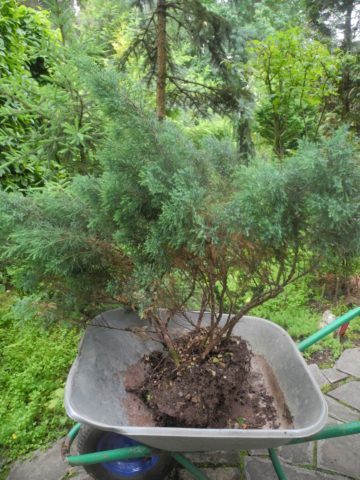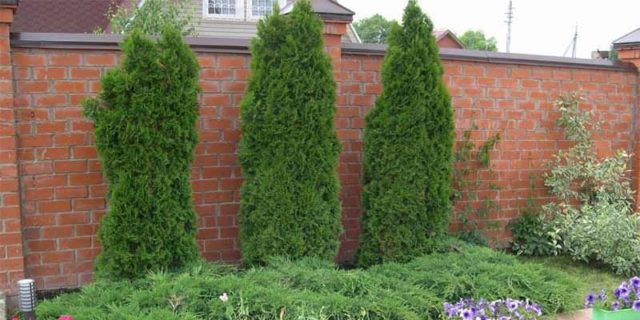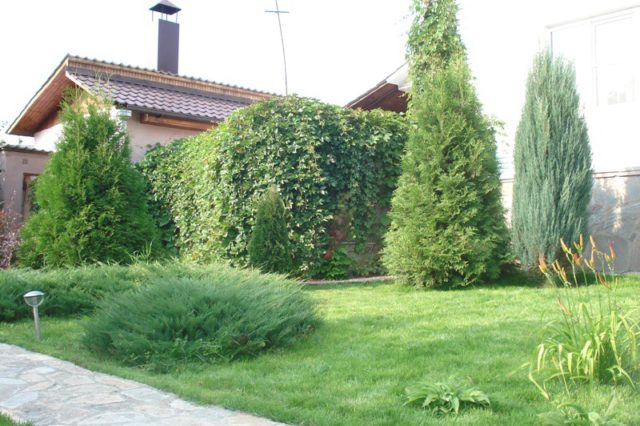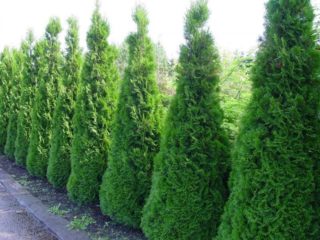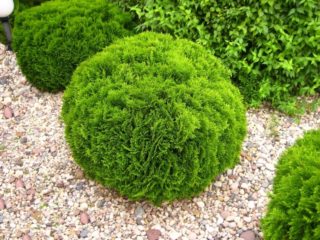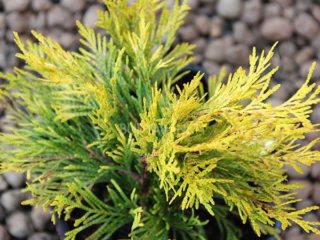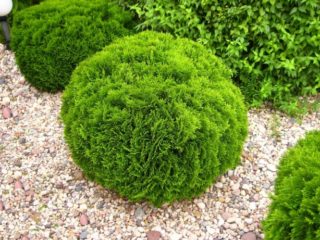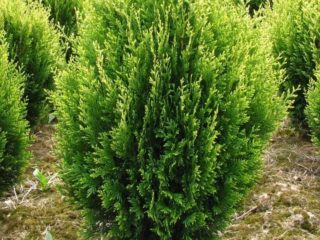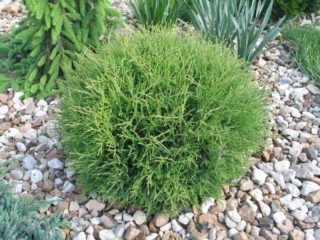Content
Replanting a thuja is not a very pleasant process, both for the tree and for the owner, but, nevertheless, it is often necessary. The reasons for transplantation can be very diverse, although, mainly, they are forced measures when unusual situations arise. The transplantation process itself is technically simple, but it can have not entirely pleasant consequences, since its root system is injured. The timing of thuja transplantation plays an important role in its success.
In what cases is it necessary to transplant the thuja to another place?
The reasons for transplanting thuja can be very diverse.Large thujas are preferentially transplanted because their too high growth (which may have been incorrectly predicted during the initial planting) interferes with the development of other plants or poses a danger to humans.
Another reason for transplants is the acquisition of mature species. This is a rational solution, and it occurs quite often. Thuja is an excellent ornamental coniferous tree, but its growth rate, especially at the beginning of its life, is low. Thuja takes a very long time to grow to adulthood, which in some cases is unacceptable for its future owner.
That is why buying an already mature thuja is quite logical and justified. However, it poses a problem in transporting the tree and replanting it. Often it even has to be replanted and brought not just from the nursery, but directly from the forest.
The third reason why a thuja may be transplanted is the design aspect. There are often situations when the thuja does not fit into the site and significantly distorts its appearance. At the same time, it either looks unsuccessful, or introduces an imbalance into the overall composition, or simply interferes with the implementation of one or another of the author’s ideas. If such problems become critical, the thuja needs to be replanted.
Is it possible to transplant an adult thuja?
All botanists and gardeners agree that it is possible to replant an adult thuja. Moreover, as practice shows, most of the transplanted thujas are already adults.
Until what age can thuja be replanted?
There are no restrictions on transplanting thuja based on age.The replanting algorithm will be the same for a young thuja for 3-5 years and for a 20-30-year-old “veteran”. However, the difference in the nuances of transplanting large and small trees can be quite significant.
In order to properly transplant an adult thuja, first of all, you will need to take care of the safety of its root system, which can pose a serious problem for large trees. For example, a difference in height of 2 times means that the mass (and with it the root system with an earthen lump) of such a tree will be 8 times greater. Such issues must be taken into account when replanting mature trees, since in this case we are talking not just about labor costs, but also about the possible use of special means.
As for the time of transplanting an adult species, the question of when to transplant a large thuja, in spring or autumn, does not depend on its age.
When can you transplant a thuja to another place?
Botanists and gardeners still do not have a clear assessment of what time of year is optimal for replanting thuja. According to observational statistics, there is no particular difference in the survival rate of trees transplanted in spring, summer or autumn. It’s just that each period of the warm season has its own characteristics, both positively and negatively affecting the adaptation of the thuja in a new place, and, as a result, its future life.
When to replant thuja in spring or autumn
The question of when to replant thuja, in spring or autumn, is a matter of personal preference for the gardener. Each period has its own characteristics:
- Transplanting thuja in the fall is good because at this time the coniferous tree has a very high chance of taking root and normalizing its metabolism.This is due, first of all, to the fact that it is with the onset of cold weather that thuja activates root regeneration, and it manages to grow additional root shoots in a relatively short period of time, as well as restore injured parts of the root system. The disadvantages include the fact that sometimes this time may not be enough, since quickly approaching frosts can only aggravate the situation with an injured root system that is not yet prepared for winter.
- Transplanting thuja to another place in the spring has other advantages. In the spring, the thuja gets much more time to adapt, so it will definitely have time to prepare for winter and restore the root system after transplantation. However, not everything is smooth here: the transplant must be carried out early enough, before the start of the growing season, otherwise disease resistance will be significantly reduced.
Based on possible risks, terrain and climate, a decision should be made at what time a transplant is necessary. For example, if the winter in the southern region is not too cold, and the warm period ends closer to November, it is advisable to transplant in the fall.
In the case of a relatively short summer and harsh winter, replanting should be carried out only in the spring.
Is it possible to replant thuja in the summer?
Transplanting an adult thuja can also be done in the summer. This period is a kind of compromise between the spring danger of getting sick and the autumn danger of not having time to form the root system. It’s just that, unlike spring or autumn transplantation, in summer it is extremely difficult to more or less reliably determine the behavior of thuja after transplantation.
How to transplant an adult thuja to another place
In order to transplant thuja from the ground without any problems, you need to decide on the transplant site and carry out preliminary work on it. The success of the entire operation will depend 80% on their correctness and effectiveness. Below are the manipulations for preparing the planting site, as well as step-by-step instructions on how to replant thuja in spring or autumn.
Where to transplant
Correctly determining the place where the thuja will be transplanted is the most important problem when transplanting. In the new place, the tree should be comfortable enough so that in the first days after transplantation it does not expend energy on any processes other than those associated with adaptation.
Thuja loves sunny areas, so there should not be tall buildings, structures, trees, etc. near it.
Thuja has a very negative attitude towards drafts, so there should not be any at its new planting site. It is equally important to protect the thuja from the winds that have a predominant direction in a given region, using artificial or natural fences.
Thuja is a calciphile, that is, it prefers alkaline soils. The nature of the soil itself can be clayey, sandy loam or even swampy. The tree prefers poor soils. It is not recommended to grow it in more nutritious areas (chernozems, etc.)
The location of groundwater should not be too close to the surface. For each variety of thuja, this value varies, but in general it is relatively small and does not exceed 1-1.5 m.On the other hand, the root system of thuja is not so vulnerable to constant moisture in the soil, so this requirement is recommended rather than mandatory.
Features of preparing the planting pit
The selected area must be cleared of weeds; it is advisable to even dig it up to a depth of 10-20 cm.
Under the thuja, dig a hole 50-70 cm deeper and wider than the earthen ball of the transplanted tree. First, the hole is filled with water and soil for the thuja is placed in it.
The composition of the soil can be as follows:
- river sand;
- peat;
- humus.
All components are taken in equal parts. In addition, wood ash and phosphorus-potassium fertilizers are added to the composition. Nitrogen fertilizers cannot be added, since the growth of the “green” part of the tree is undesirable at this stage.
How to transplant a large thuja
The procedure for transplanting an adult thuja is as follows:
- Dig and prepare the planting hole according to the algorithm specified earlier. All work must be completed 3-4 months before planting.
- Closer to the time of planting, an additional 100 g of ash and up to 300 g of humus are added to the pit. The supply of nutrients in these fertilizers is sufficient so that the tree does not need additional feeding throughout the year. These operations must be completed 15-20 days before transplantation.
- The transplant should be done on a cloudy day. It is necessary to dig the thuja out of the ground and transport it to a new planting site. In this case, it is recommended to retreat from the tree when digging out its root system by at least half a meter. The thuja itself can be removed from the ground along with an earthen lump by prying it up with a fork. It is recommended that at least two people perform the operation.
- The root system must be wrapped with burlap or any other material during transportation. The tree must be moved on a flat surface (plywood, plank flooring, etc.)
- After transportation, the protective material is removed from the earthen lump, the lump is placed in a hole, covered with earth and thoroughly compacted. In this case, you need to get rid of all air cavities that may form.
- The soil is thoroughly watered until water stops seeping into the soil.
At this point, the process of transplanting a large thuja can be considered complete.
How to transplant a small thuja
There are no problems with transplanting young trees. Everything that applies to large species can also be applied to small ones. In addition, replanting small thujas is much simpler, since in the vast majority of cases they are not transplanted from soil to soil, but from pot to soil. That is, this is the first transplant of the tree after its purchase.
Site selection and soil preparation
Choosing a place when planting a small thuja is similar to choosing a place for an adult, however, the requirements for midday shading in this case have a certain feature.
Unlike adult species, where midday shading is advisory, for small thujas it is mandatory. In addition, in the first few years after transplantation, a young tree needs diffused rather than direct sunlight. Therefore, it is recommended to plant thuja either in partial shade or behind a trellis, with the help of which it will be shaded or provided with diffused light.
Transplant algorithm
The algorithm for transplanting a small thuja is similar to transplanting a large tree. There are practically no differences.However, we should not forget that summer transplantation of young species is less effective in terms of their survival rate. The tree is unlikely to die, since thujas are quite tenacious, but the adaptation process may take a significant amount of time.
Caring for thuja after transplantation
After you have managed to transplant the thuja to another place in the spring or autumn, it is necessary to carry out certain care for it. It is slightly different from caring for a regular look and includes the following activities:
- The soil should not be allowed to dry out, even for relatively short periods. Thujas in a “normal” state are able to withstand droughts for up to 2 months, but after transplantation they are very vulnerable and can quickly lose their decorative properties. In addition, recovery time after drought can take more than one year.
- During the year of transplantation, you should not engage in pruning, even sanitary pruning. It is recommended that all activities related to pruning be carried out next spring, about a week before the start of the active growing season of the thuja.
- The tree may require additional nutrition in the form of fertilizing, but you should not fertilize the thuja too much. The first fertilizing can be done with urea in May next year. Then apply potash fertilizer in mid-summer. Phosphorus fertilizers are generally not recommended. They can be used in cases of excessive weakness after transplantation and in situations where the soil is very poor in nutrients.
- It is strongly recommended that after the first watering, mulch the soil with sawdust or coconut fiber. This will not only help the root system retain moisture for a longer period of time, but will also provide it with additional protection.
- Preventative measures to combat pests and parasites should be carried out monthly.
- Seasonal pruning and, in general, any work with the crown is allowed no earlier than 2-3 years after transplantation for young thujas and no earlier than 1 year for adults.
Using these simple rules, you can transplant the thuja without any problems and provide it with all the conditions for normal growth in its new location.
Conclusion
In fact, replanting a thuja is a relatively simple process. The main thing is to remember the basic rules regarding the seasonality of this event, as well as subsequent actions to maintain the tree while adapting to a new place. As the experience of gardeners who grow thujas shows, on average it takes 2 to 3 years to adapt, regardless of their age.
